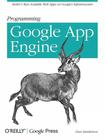Google App Engine编程
出版时间:2011-1 出版社:东南大学出版社 作者:Dan Sanderson 丹·桑德森 页数:367
Tag标签:无
内容概要
google app
engine是一种与众不同的云计算服务:它为构建自动扩展的百万用户级应用提供了简单的模型。在《google app
engine编程》中,你将获得来自专家的实用指南,帮助你用奸这个强大的平台。google工程师dan
sanderson将向你展示如何设计可扩展的应用,以及如何使用app engine的api和可扩展服务完成一般的开发任务。
你将学习appengine的应用服务器架构、运行时环境和可扩展的数据存储,还有优化应用的相关技巧。app
engine可以提供几乎无限的计算能力,《google app
engine编程:英文版》给出了简明扼要的指导,以便最大化利用其资源——信息来自app engine开发团队。
·发现传统web开发和app engine开发之间的差异
·学习app engine python和java运行时环境的细节
·理解app engine如何处理web请求并执行应用代码
·学习如何使用app engine的可扩展数据存储,包括查询和索引、事务以及数据建模
·使用任务队列在基础设施中并行化和分布工作
·轻松部署和管理应用
作者简介
Dan
Sanderson是一位技术作家、Google公司的软件工程师。他作为Google、Amazon.com和Walt
Disney互联网集团的软件工程师和技术作家在Web行业工作超过十年。
书籍目录
preface xiii
1. introducing google app engine
the runtime environment
the static file servers
the datastore
entities and properties
queries and indexes
transactions
the services
google accounts
task queues and cron jobs
developer tools
the administration console
things app engine doesn’t do...yet
getting started
2. creating an application
setting up the sdk
installing the python sdk
installing the java sdk
developing the application
the user preferences pattern
developing a python app
developing a java app
the development console
registering the application
the application id and title
setting up a domain name
google apps and authentication
uploading the application
introducing the administration console
3. handling web requests
the app engine architecture
configuring the frontend
configuring a python app
configuring a java app
domain names
app ids and versions
request handlers
static files and resource files
secure connections
authorization with google accounts
how the app is run
the python runtime environment
the java runtime environment
the sandbox
app caching
logging
quotas and limits
request limits
cpu limits
service limits
deployment limits
billable quotas
resource usage headers
4. datastore entities
entities, keys, and properties
introducing the python datastore api
introducing the java datastore api
property values
strings, text, and blobs
unset versus the null value
multivalued properties
keys and key objects
using entities
getting entities using keys
inspecting entity objects
saving entities
deleting entities
5. datastore queries
6. datastore transactions
7. data modeling with python
8. the java persistence api
9. the memory cache 227
10. fetching urls and web resources
11. sending and receiving mail and instant messages
12. bulk data operations and remote access
13. task queues and scheduled tasks
14. the django web application framework
15. deploying and managing applications
index
章节摘录
版权页:插图:The Java environment runs applications built for the Java 6 Virtual Machine 0VM).An app can be developed using the Java programming language, or most other lan-guages that compile to or otherwise run in the JVM, such as PHP (using Quercus),Ruby (using JRuby), JavaScript (using the Rhino interpreter), Scala, and Groovy. Theapp accesses the environment and services using interfaces based on web industrystandards, including Java servlets and the Java Persistence API (JPA). Any Java tech-nology that functions within the sandbox restrictions can run on App Engine, makingit suitable for many existing frameworks and libraries. Notably, App Engine fully sup-ports Google Web Toolkit (GWT), a framework for rich web applications that lets youwrite all of the app's code——including the user interface——in the Java language, andhave your rich graphical app work with all major browsers without plug-ins.The Python environment runs apps written in the Python 2.5 programming language,using a custom version of CPython, the official Python interpreter. App Engine invokesa Python app using CGI, a widely supported application interface standard. An appli-cation can use most of Python's large and excellent standard library, as well as rich APIsand libraries for accessing services and modeling data. Many open source Python webapplication frameworks work with App Engine, such as Django, web2py, and Pylons,and App Engine even includes a simple framework of its own.The Java and Python environments use the same application server model: a request isrouted to an app server, the application is started on the app server (if necessary) andinvoked to handle the request to produce a response, and the response is returned tothe client. Each environment runs its interpreter (the JVM or the Python interpreter)with sandbox restrictions, such that any attempt to use a feature of the language or alibrary that would require access outside of the sandbox fails with an exception.
媒体关注与评论
“毋庸置疑,这是最全面、易读以及内容最新的App Engine图书。我想这么说是恰如其分的,如果你从头到尾一页不漏地读完这本书,那么现在肯定是App Engine专家了。” ——Kevin Gibbs技术领导者兼经理,Google App Engine团队
编辑推荐
《Google App Engine编程(影印版)》:·发现传统web开发和app engine开发之间的差异·学习app engine python和java运行时环境的细节·理解app engine如何处理web请求并执行应用代码·学习如何使用app engine的可扩展数据存储,包括查询和索引、事务以及数据建模·使用任务队列在基础设施中并行化和分布工作·轻松部署和管理应用
图书封面
图书标签Tags
无
评论、评分、阅读与下载
用户评论 (总计0条)
推荐图书
- 日語範本(上)
- 日語範本下
- 日本語
- おほよう日本語進階教材(上)
- 空中日語講座(全)
- 生活日語會話(上)
- 生活越南語(初級會話)
- 最糟也最棒的书店
- 日本の写真家(1):上野彦馬と幕末の写真家たち
- 生活印尼語會話(初級)
- 日本の写真家(2): 田本研造と明治の写真家たち
- 寻找幸运星
- 生活印尼語會話2:進階篇
- 日本の写真家(3): 福原信三と福原路草
- 我们生活的风景
- 標準泰國語(初級會話)
- 日本の写真家(4):野島康三
- 輕鬆學好韓語(一)基礎篇 (Book+2CDs)
- 輕鬆學好韓語(二)初級韓語句型 (Book+2CDs)
- 輕鬆學好韓語(三)中級韓語句型
- 輕鬆學好韓語(四)進級韓語句型(書+CD)
- 進擊的巨人 01
- 輕鬆學好韓語(五)
- 進擊的巨人 02
- 日本の写真家(6):淵上白陽と満洲写真作家協会
